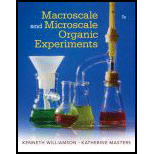
Interpretation:
The reason for the use of gravity filtration instead of suction filtration to remove the suspended impurities and charcoal from a hot solution should be explained.
Concept introduction:
Gravity filtration is the process that is used to separate the solids from liquids based on the particle size with the help of gravity. This method is used when the filtrate is to be retained and the residue on the filter paper is discarded. It is a slow process and removes only large particles from the air.
Suction filtration is a technique that is used to separate the mixtures of solids and liquids. This method is used when the solid is to be retained and the filtrate is discarded. It is much faster than gravity filtration.
Trending nowThis is a popular solution!

Chapter 4 Solutions
Macroscale and Microscale Organic Experiments
- Vacuum filtration is just one method that can be used to separate the components of a mixture. Describe another method for separating the components of a mixture, and comment on how "green" the method is. Be sure to indicate the physical state of each component during separation. Scientific literature should be cited as part of your response.arrow_forwardhow to use Gas Chromatography in Cosmetics Provide a procedure on how to do this example that you provided. Explain the procedure and what data would you gather?arrow_forwardA sample of fried potatoes weighing 200 g was extracted using a volatile organic solvent. The recovered cooking oil weighed 15 g. What methods from this experiment could be used to separate the cooking oil after the extraction? What was the percent oil in the potatoes? Show your calculations. How is gravity filtration different from vacuum filtration? Give examples of mixtures that can be separated by gravity filtration.arrow_forward
- 2. Explain how suction filtration is carried out in the laboratory. Give the important points that must be observed in doing the process.arrow_forwardWeigh out accurately 9.99 g of copper(II) sulfate pentahydrate (CuSO4·5H2O) by taring using a clean and dry empty 250-ml beaker. 2. Add tap water to the beaker to reach the 50-mL mark on the side of the beaker. 3. Dissolve all the crystals of CuSO4·5H2O in the water using a clean glass rod for stirring. 4. Then using a glass funnel transfer all the blue solution to a 100-mL volumetric flask. Rinse the beaker with about 10 mL of water and transfer the solution to the volumetric flask. Repeat the rinsing of the beaker with another 10 mL of water and transfer the solution to the volumetric flask. This is called quantitative transfer of the solution. 5. Then add enough water to reach the calibration mark of the volumetric flask. (You will need to use a dropper to add the last few drops of water to ensure the meniscus is on the calibration mark). Close the volumetric flask with a stopper and mix the solution well (so that it is homogeneous). 6. You have now prepared a standard solution (or…arrow_forwardIndicate which of the two filtration techniques, gravity ( G ) or vacuum ( V ), is suitable for each of the following operations. a) Hot filtration b) Removal of decolourising carbon c) Isolation of recrystallized solute from solution.arrow_forward
- What are the types of gravimetric methods? Give an examples where each method is used in an analysis. What is particulate gravimetry? When do we use this technique?arrow_forwardDuring a laboratory experiment, a student mixed two homogeneous aqueous solutions. After mixing a solid precipitate was formed. What is the best way for the solid to be separated from the solution? Put it in a beaker and heat it. Filter it using a Buchner funnel, filter flask and vacuum pump. Use a pipette to remove the solid from the liquid. Scoop it out with a spatula. The solid cannot be isolated.arrow_forward1. A 25-mL specific gravity bottle was found to weigh 46.05 g when filled with water, and 52.93 g when filled with the ophthalmic solution. If the empty specific gravity bottle weighs 21.04 g, what is the specific gravity of the ophthalmic solution? a 0.784 b 0.870 c 1.149 d 1.275arrow_forward
- Consider four distinct physical properties: boiling point, melting point, solubility, and density. Which of these physical properties do you think allows thin layer chromatography (TLC) to work? Choose one then, explain your reasoning.arrow_forwardWhich solvent should be used to wash the solid material collected from a filtration? Select one: The same solvent as the liquid in the original mixture Acetone Deionized water O Any solvent in which the solid can dissolvearrow_forwardWhich one is the most common method used for the purification of liquid mixtures? Filtration Chromatography Evaporation Distillationarrow_forward
 Macroscale and Microscale Organic ExperimentsChemistryISBN:9781305577190Author:Kenneth L. Williamson, Katherine M. MastersPublisher:Brooks Cole
Macroscale and Microscale Organic ExperimentsChemistryISBN:9781305577190Author:Kenneth L. Williamson, Katherine M. MastersPublisher:Brooks Cole Chemical Principles in the LaboratoryChemistryISBN:9781305264434Author:Emil Slowinski, Wayne C. Wolsey, Robert RossiPublisher:Brooks Cole
Chemical Principles in the LaboratoryChemistryISBN:9781305264434Author:Emil Slowinski, Wayne C. Wolsey, Robert RossiPublisher:Brooks Cole Chemistry: The Molecular ScienceChemistryISBN:9781285199047Author:John W. Moore, Conrad L. StanitskiPublisher:Cengage Learning
Chemistry: The Molecular ScienceChemistryISBN:9781285199047Author:John W. Moore, Conrad L. StanitskiPublisher:Cengage Learning Chemistry & Chemical ReactivityChemistryISBN:9781337399074Author:John C. Kotz, Paul M. Treichel, John Townsend, David TreichelPublisher:Cengage Learning
Chemistry & Chemical ReactivityChemistryISBN:9781337399074Author:John C. Kotz, Paul M. Treichel, John Townsend, David TreichelPublisher:Cengage Learning



